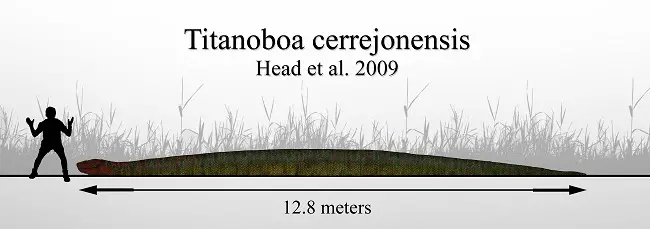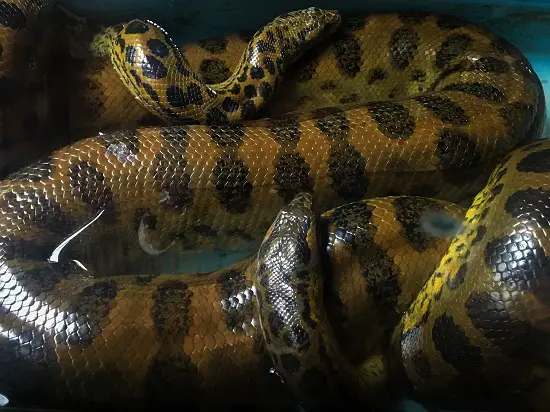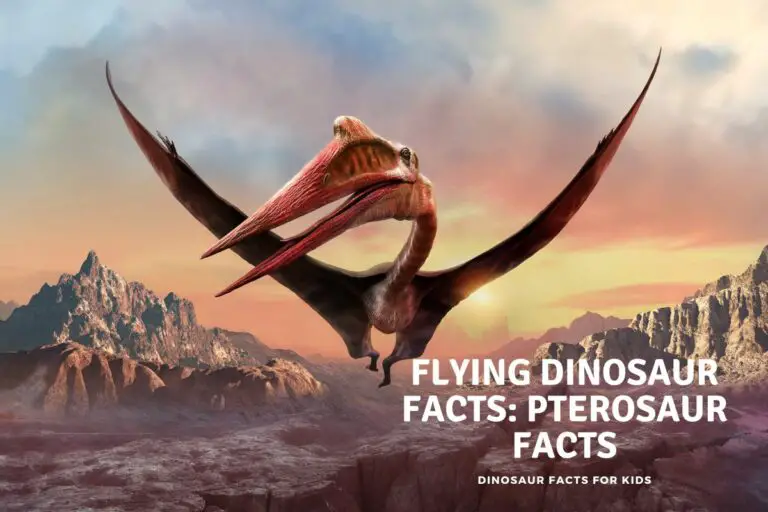Titanoboa Facts
Titanoboa is the largest snake ever on Earth, and it lived 5 million years after the dinosaurs. So while it never could meet a T-Rex, it lived in a different area as well, it was certainly dinosaur like in appearance with its huge length and massive jaws. We will explore all the titanoboa facts we know about this super snake below.
Titanoboa is an Extinct constrictor snake that lived over 58 million years ago in what is now Columbia. It could reach lengths exceeding 47 feet and weighed up to 4000 lbs. This is in part due to Earths warmer conditions facilitating cold blooded reptile growth, its diet consisted of crocodiles, turtles and fish.

Titanoboa lived shortly after the age of the dinosaurs, close enough that we think it deserves looking at on a dinosaur site at least. That and the fact that a 60 ft long 3 feet wide snake is simply awesome and we wanted to know more. You can read below what we found out about this biggest ever snake!
You can check some of these in the fast Facts below, and don’t forget to check out our printable fact sheets to download, print and add to your collection! ,It may not be a dinosaur but it was still very worth learning about!
So let’s wrap up our titanoboa fast facts in case you are pressed for time (sorry!)
Titanoboa Quick Facts

- Titanoboa is estimated to be able to achieve over 47 feet in length and possibly even longer.
- Titanoboa is thought to be an average weight of around 2500 lbs (1135 kg) That is almost the same as a fully grown hippo! Larger titanoboa may have been up to 4000 lbs
- Warmer temperatures allowed cold blooded animals like snakes and crocodiles to grow much larger than today
- It was a predatory and very carnivorous animal that ate large turtles, large crocodiles and fish It would prey on these either by constrictions and squeezing like modern day pythons or by using its weight to stun and kill its prey by hitting them hard.
- The name Titanoboa means ‘Titan boa or basically massive boa’ It got this name, unsurprisingly due to its huge size.
- Its closest competition is another extinct snake called the Gigantophis a snake that lived in Africa reached up to 32 feet in length.
- Titanoboa is an easy name to pronounce. it has four syllables and is said like this. Tie – Tan – Oh – Bow – Ah
How big was the Titanoboa?
Titanoboa is estimated to be able to achieve over 47 feet in length and possibly even longer. It is the largest snake ever discovered by quite a distance and although may have been the apex predator of its time and era has recently thought to prey mainly on fish.
How heavy was the Titanoboa?
With that 47 feet in length came a massive weight as well. Titanoboa is thought to be an average weight of around 2500 lbs (1135 kg) That is almost the same as a fully grown hippo! Larger titanoboa may have been up to 4000 lbs or 1800 kg.

Was Titanoboa a Dinosaur?
Although dinosaur sized, dinosaur looking and a dinosaur appetite Titanoboa was not a dinosaur. It lived approximately 5-6 million years after the extinction of the dinosaurs and was a snake, which existed as a separate species to dinosaurs.
To be a dinosaur there are a few biological traits an animal needs to show, one of these is legs and their position in dinosaurs they come strait out of the body, not at the side. titanoboa did not have legs at all! it was a snake.

How Fast Could the Titanoboa Move?
Although the speed of a Titanoboa was estimated at 50 miles per hour on land, this is both unproven and unlikely. It would make it over 2 times faster than the fastest snake in the world either the sidewinder or the black mamba which have both been recorded at 18 and 23 kph ( 14-15 miles an hour)
However Titanoboa is thought to be an excellent swimmer, and fast enough through the water to catch massive fish regularly.
Why did Titanoboa Grow so large?
During the time of the titanoboa the Earth was much warmer, and average of 32 degrees. These warmer temperatures allowed cold blooded animals like snakes and crocodiles to grow much larger than today. Even today if you move away from the hot temperatures of the equator cold blooded animals get much smaller.
What did a Titanoboa eat?
It was a predatory and very carnivorous animal that ate large turtles, large crocodiles and fish It would prey on these either by constrictions and squeezing like modern day pythons or by using its eight to stun and kill its prey by hitting them hard in ambush attacks.
What Movies Have Featured a Titanoboa?
The Documentary Titanoboa Monster Snake focuses on the Discovery of the Titanoboa fossils. there is also a sci-fi movie about titanoboa being made at the moment.

When Did the Titanoboa become extinct?
They became extinct about 59 to 60 million years ago; they lived during the Paleocene Epoch era ad as the Earth cooled they were unlikely to be able to adapt quickly enough.
Could the Titanoboa swim?
It was a great swimmer and was able to swim at fast speeds it is thought to live in swampy muddy water and hunt crocodiles, turtles and in the deeper water fish.
What does the name Titanoboa mean?
The name Titanoboa means ‘Titan boa or basically massive boa’ It got this name, unsurprisingly due to its huge size.
Was Titanoboa the largest ever snake on Earth?
It was likely to be the apex predator of its environment, and is the bigger ever recorded snake at up to 47 feet and 4000 lbs. Its closest competition is another extinct snake called the Gigantophis a snake that lived in Africa reached up to 32 feet in length.
Was Titanoboa Warm or Cold-Blooded?
Titanoboa like all snakes was a cold-blooded animal. It is one of the reasons it was able to grow to such a huge size. The Earth was warmer and allowed cold blooded animals to grow more.
Where can you find Titanoboa Fossils (Where were they discovered)?
The fossils of Titanoboa were found in a coal mine in Northern Columbia, tropical South America. It was identified first from a vertebrae but more fossils were found including fragments of skulls. it is very rare to find fossilized snake skulls as they are often crushed ( a snakes’ power is in the muscles not the bones and they are more fragile than you would imagine.
However the fossils of over 28 of these massive snakes have been found, and three pieces of skulls. Enough for these to put together a fossil replica of titanoboa
Were Titanoboa Teeth Sharp?
Yes, they were very sharp and pointed backwards in tis mouth. This was designed to push prey back towards their stomach and give no chance of escape.
Who discovered the Titanoboa?
The snake was discovered in 2009 expedition led by paleontologists Carlos Jaramillo and Jonathan Bloch from the Tropical research institute in Panama and the university of florida. This expedition discovered 30 fossils of titanoboa in the Cerrejon Formation of columbia.
What was the width of Titanoboa?
On average, its width was 36 inches (3 feet). that is about the same as human leg and this width allowed it to swallow its prey whole, even large turtles and crocodiles.
How Big was the titanoboa Head?
Titanoboas head was scaled to its massive body, wide enough to swallow crodiles whole and lined with teeth to prevent any escape once prey was inside. From Estimates it could be up to 2 feet wide with a mouth that opens much wider.
What was Titanoboas Habitat?
Titanoboa lived in tropical rainforests and rivers in what is now columbia, The area at the time was home to turtles, crocodiles fish and other freshwater animals which is where titanoboa found its food source.
It was certainly the largest predator at the time and in this environment.
Was the Titanoboa venomous.
There is no evidence suggesting that Titanoboa was venomous, it was more likely to be an ambush or constricting predator like similar species like the python and the anaconda. and some studies have found that snake venom can only be traced back to around 28 million years ago. However there is alternative views that suggest venom may actually be as old as 170 million years!
You can read more about poisonous dinosaurs here on our site.
What Pressure Could a Titanoboa Constrict its Prey?
Titanoboa was a massive snake and it could constrict its prey at 400 lbs per square inch.That is the equivalent of 3 Eiffel Towers pressing down.
Did Titanoboa Live At The Same time As Dinosaurs?
Titanoboa and dinosaurs are separated by at least 5 million years according to current fossil discoveries and would never have encountered each other.
When did Titanoboa Live?
Titanoboa lived in what is now Columbia around 60-58 million years go, around 6 years after the extinction of the dinosaurs.

How to Pronounce Titanoboa?
Titanoboa is an easy name to pronounce. it has four syllables and is said like this. Tie – Tan – Oh – Bow – Ah
Tie – Tan – Oh – Bow – Ah
Conclusion
So titanoboa was not a dinosaur, we don’t care! It was longer than a T-Rex, heavier than a velociraptor, and taller, well not taller than much, but let’s say a pyroraptor. it lived only a few million years after the dinosaurs in tropical jungles and was an apex predator of its time.
Oh, and it ate crocodiles! which is pretty awesome!
Don’t forget to look over the rest of our dinosaur facts pages, our coloring and facts sheets are also free to download. We have popular dinosaurs Like Pyroraptor and Dreadnoughtus and to some less well known ones that are appearing in the new Jurassic World dominion movies.
There are answers to common dinosaur questions, and loads of other cool dinosaur activities and resources to look at. Just check them out on the big button below.
References
https://en.wikipedia.org/wiki/Titanoboa
https://www.britannica.com/animal/Titanoboa
https://allthatsinteresting.com/titanoboa-snake
Hi, I am Roy Ford a General Studies and English Teacher who has taught all over the world. What started as a fossil collection became a great way to teach, motivate and inspire students of all ages and all over the world about dinosaurs and from that and children’s love of dinosaurs came the site dinosaur facts for kids, a resource for all ages.









